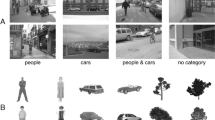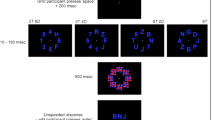Abstract
Active vision systems, and especially foveated vision systems, depend on efficient attentional mechanisms. We propose that machine visual attention should consist of both high-level, context-dependent components, and low-level, context free components. As a basis for the context-free component, we present an attention operator based on the intuitive notion of symmetry, which generalized many of the existing methods of detecting regions of interest. It is a low-level operator that can be applied successfully without a priori knowledge of the world. The resultingsymmetry edge map can be applied in various low, intermediate-and high- level tasks, such as extraction of interest points, grouping, and object recognition. In particular, we have implemented an algorithm that locates interest points in real time, and can be incorporated in active and purposive vision systems. The results agree with some psychophysical findings concerning symmetry as well as evidence concerning selection of fixation points. We demonstrate the performance of the transform on natural, cluttered images.
Similar content being viewed by others
Explore related subjects
Discover the latest articles, news and stories from top researchers in related subjects.References
Aboot, A.L. and Ahuja, N., 1988. Surface reconstruction by dynamic integration of focus, camera vergence and stereo,Proc. 2nd Intern. Conf. Comput. Vis., Tampa, FL.
Aloimonos, J.Y., Weiss, I., and Bandyopadhyay, A., 1987. Active vision,Intern. J. Comput. Vis., 1:334–356.
Antes, J.R., 1974. The time course of picture viewing,J. Psychol., 103:62–70.
Atallah, M.J., 1985. On symmetry detection,IEEE Trans Comput. C-34:663–666.
Attneave, F., 1954. Informational aspects of visual perception,Psychological Review, 61:183–193.
Bajcsy, R., 1988. Active perception.Proc. IEEE, 76(8):996–1006.
Ballard, D., 1990. Animated vision, Tech. Rep. TR 61, University of Rochester, Department of Computer Science, 1990.
Bigun, J., 1988. Pattern recognition by detection of local symmetries. In E.S. Gelsma and L.N. Kanal, eds., Pattern Recognition and Artificial Intelligence, Elsevier, North Holland, pp. 75–90.
Blum, H. and Nagel, R.N., 1978. Shape description using weighted symmetric axis features,Pattern Recognition, 10:167–180.
Bonneh, Y., Reisfeld, D., and Yeshurun, Y., 1993. Texture discrimination by local generalized symmetry,Proc. 4th Intern. Conf. Comput. Vis., Berlin.
Brady, M. and Asada, H., 1984. Smooth local symmetries and their implementation,Intern. J. Robot. Res. 3(3):36–61.
Brunnstrome, K., Lindeberg, T., and Eklundh, J.O., 1992. Active detection and classification of junctions by foveation with a head-eye system guided by the scale-space primal sketch,Proc. 2nd Europ. Conf. Comput. Vis., Santa Margherita, Ligure, Italy, 7:701–709.
Cohen, K., 1981. The development of strategies of of visual search, in eye movements. In D. Fisher, R. Monty, and J. Senders, Ed., Cognition and Visual Perception, Laurence Erlbaum Assoc: Hillsdale NJ, pp. 299–314.
Crowley, J.L., 1991. Towards continuously operating integrated vision systems for robotics applications,SCIA-91, 7th Scandinavian Conf. Image Anal, Aalborg.
Culhane, S.M. and Tsotsos, J.K., 1992. An attentional prototype for early vision,Proc. 2nd Europ. Conf. Comput. Vis., S. Margherita, Ligure, Italy, May, pp. 551–560.
Davis, L.S., 1977. Understanding shape: Ii. symmetry,IEEE Trans. Syst. Man, Cybern. 7:204–211.
Edelman, S., Reisfeld, D., and Yeshurun, Y., 1992. Learning to recognize faces from examples,Proc. 2nd Europ. Conf. Comput. Vis., Santa Margherita, Ligure, Italy, 7:787–791.
Haith, M.M., Bergman, T., and Moore, M.J., 1977, Eye contact and face scanning in early infancy, Science 198:853–855.
Kanade, J. and Kender, J.P., 1983. Mapping image properties into shape constraints: skewed symmetry, affine-transformable patterns, and the shape-from-texture paradigm. In Beck, Hope and Rosenfeld, eds., Human and Machine Vision, Academic Press: New York.
Kaufman, L. and Richards, W. 1969. Spontaneous fixation tendencies for visual forms,Perception and Psychophysics, 5(2):85–88.
Lamdan, Y., Schwartz, J.T., and Wolfson, H., 1988. On recognition of 3-d objects from 2-d images,Proc. IEEE Intern. Conf. Robot. Autom. Philadelphia, 1407–1413.
Locher, P.J. and Nodine, C.F., 1986. Symmetry catches the eye. In A. Levy Schoeh (ed.),Eye Movements: From Physiology to Cognition, Elsevier: North Holland, pp. 353–361.
Loftus, G. and Mackworth, N., 1978. Cognitive determinants of fixation location during picture viewing,Human Perception and Performance 4:565–572.
Marola, G., 1989. On the detection of the axis of symmetry of symmetric and almost symmetric plannar images,IEEE Trans. Patt. Anal. Mach. Intell., 11(1):104–108.
Moravec, H.P., 1977. Towards automatic visual obstacle avoidance,5th Intern. Joint Conf. Artif. Intell. Cambridge, MA, pp. 584–590.
Nevatia, R. and Binford, T.O. 1977. Description and recognition of curved objects.Artificial Intelligence, 8:77–98.
Posner, M.L. and Peterson, S.E., 1990. The attention system of the human brain.,Annu. Rev. Neurosci. 13:25–42.
Reisfeld, D., 1994.Generalized symmetry transforms: attentional mechanisms and face recognition, Ph.D. thesis, Computer Science Department, Tel-Aviv University, January.
Reisfeld, D., Wolfson, H., and Yeshurun, Y., 1990. Detection of interest points using symmetry,Proc. 3rd Intern. Conf. Comput. Vis., Osaka, Japan, December, pp. 62–65.
Reisfeld, D. and Yeshurun, Y., 1992. Robust detection of facial features by generalized symmetry,Proc. 11th Intern. Conf. Image Anal. Patt. Recog., The Hague, The Netherlands, August, pp. 117–120.
Rimey, R.D. and Brown, C.M., 1992. Where to look next using a bayes net: incorporating geometric relations,Proc. 2nd Europ. Conf. Comput. Vis., S. Margherita, Ligure, Italy, May, pp. 542–550.
Rojer, A. and Schwartz, E., 1990. Design considerations for a space-variant visual sensor with complex logarithmic geometry,Proc. 10th Intern. Conf. Patt. Recog., pp. 278–285.
Salapatek, P. and Kessen, W., 1973. Prolonged investigation of a plane geometric triangle by the human newborn,J. Exper. Child Psychol. 15:22–29.
Tistarelli, M. and Sandini, G., 1990. Estimation of depth from motion using an anthropomorphic visual sensor,Image Vis. Comput., 8(4):271–278.
Ullman, S., 1984. Visual routines,Cognition, 18:97–159.
Xia, Y., 1989. Skeletonization via the realization of the fire front's propagation and extinction in digital binary shapes.IEEE Trans. Patt. Anal Mach. Intell., 11(10): 1076–1089.
Yeshurun, Y. and Schwartz, E.L., 1989. Shape description with a space-variant sensor: Algorithm for scan-path, fusion, and convergence over multiple scans,IEEE Trans. Patt. Anal. Mach. Intell.,11(11):1217–1222.
Yuille, A. and Leyton, M., 1990. 3d symmetry-curvature duality theorems,J. Comput. Vis. Graphics, Image Process. 52:124–140.
Zabrodsky, H., Peleg, S., and Avnir, D., 1992. A measure of symmetry based on shape similarity,Proc. Conf. Comput. Vis. Patt. Recog., Champaign, IL, June.
Zucker, S.W., Dobbins, A., and Iverson, L., 1989. Two stages of curve detection suggest two styles of visual computation,Neural Computation 1:68–81.
Author information
Authors and Affiliations
Rights and permissions
About this article
Cite this article
Reisfeld, D., Wolfson, H. & Yeshurun, Y. Context-free attentional operators: The generalized symmetry transform. Int J Comput Vision 14, 119–130 (1995). https://doi.org/10.1007/BF01418978
Received:
Revised:
Issue Date:
DOI: https://doi.org/10.1007/BF01418978




